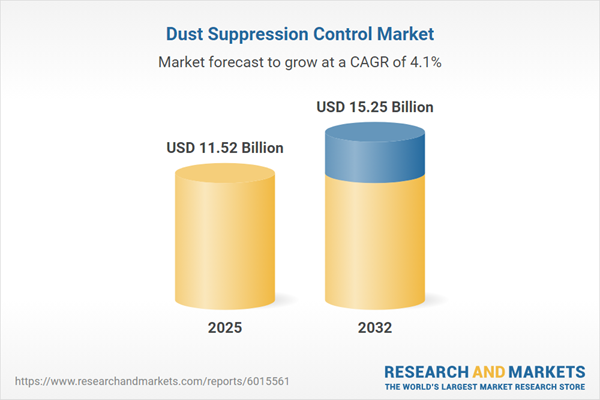Speak directly to the analyst to clarify any post sales queries you may have.
The dust suppression control market is undergoing rapid transformation, driven by heightening regulatory demands, advances in digitalization, and the growing emphasis on environmental sustainability within industrial and construction sectors. For executives seeking strategic clarity amid operational complexity, this report distills market evolution, segment priorities, and actionable insights to empower informed decision-making for long-term dust control strategies.
Market Snapshot: Dust Suppression Control Market Size and Growth
The global dust suppression control market grew from USD 11.08 billion in 2024 to USD 11.52 billion in 2025. Sustained growth is anticipated at a CAGR of 4.07%, projecting the market to reach USD 15.25 billion by 2032. This reflects strong momentum as industries respond to environmental expectations and operational risks linked to dust exposure.
Scope & Segmentation of the Dust Suppression Control Market
- End Use Industry: Construction—including both building and road construction; mining (open pit and underground); oil & gas; ports & terminals.
- Product Type: Chemical additives; foaming agents; polymer-based solutions (natural polymers, synthetic polymers); water-based solutions (fresh water, recycled water).
- System Type: Fixed systems (central and decentralized systems); mobile systems (trailer-mounted, truck-mounted); portable devices.
- Distribution Channel: Direct sales; distributors; online retail.
- Regional Coverage: Americas (North America including United States, Canada, Mexico; Latin America with Brazil, Argentina, Chile, Colombia, Peru); Europe, Middle East & Africa (Europe including United Kingdom, Germany, France, Russia, Italy, Spain, Netherlands, Sweden, Poland, Switzerland; Middle East with United Arab Emirates, Saudi Arabia, Qatar, Turkey, Israel; Africa including South Africa, Nigeria, Egypt, Kenya); Asia-Pacific (China, India, Japan, Australia, South Korea, Indonesia, Thailand, Malaysia, Singapore, Taiwan).
- Leading Companies: Veolia Environnement S.A.; Suez S.A.; Ecolab Inc.; FLSmidth & Co. A/S; Kemira Oyj; CECO Environmental Corp.; Eriez Manufacturing Co.; ZDS Inc.; Dakota Water Solutions, LLC; Dust Control Technology, LLC.
Key Takeaways for Senior Decision-Makers
- Digitalization enables real-time monitoring of particulate levels, supporting targeted interventions that reduce operational costs and chemical consumption.
- Regulatory pressures are accelerating demand for sustainable formulations, eco-friendly additives, and compliance-driven procurement.
- Technological advances, including autonomous spraying vehicles and sensor-integrated platforms, are enhancing operational safety and system efficiency across hazardous and remote work sites.
- Strategic regional opportunities vary, with North America favoring advanced monitoring and compliance, EMEA prioritizing low-impact additives, and Asia-Pacific focusing on scalable, cost-effective solutions for infrastructure growth.
- Industry collaboration and supply chain partnerships are pivotal for addressing supply disruptions, optimizing pricing models, and streamlining distribution networks.
- Companies with sustainability certifications and data-driven processes are best equipped to differentiate through performance validation and stakeholder engagement.
Tariff Impact and Supply Chain Adaptation
Recent United States tariff policies have driven up costs for raw materials and equipment, creating margin pressure for manufacturers and suppliers. In response, industry players are reassessing procurement strategies, exploring domestic sourcing, and adopting pass-through pricing models. These measures, while helping stabilize costs, have implications for demand in price-sensitive segments such as construction and mining. Strong supplier alliances and flexible inventory planning are emerging as effective responses to these fiscal uncertainties.
Methodology & Data Sources
This report is based on a robust multi-source methodology, combining a review of industry literature, regulatory documents, and technical white papers with primary interviews of executives, product managers, and compliance officers across core sectors. Quantitative data were triangulated with survey responses and validated using peer and consultant reviews to ensure accuracy and current market alignment.
Why This Report Matters to Industry Executives
- Equips decision-makers with clear segmentation analysis and qualitative insights to shape strategic investments aligned with regional and regulatory priorities.
- Delivers actionable context on supply chain shifts, technology integration, and sustainability standards—empowering leaders to proactively address compliance and operational risks.
- Enables targeted resource allocation by clarifying product, system, and distribution trends relevant to diverse end use industries and geographic markets.
Conclusion
The dust suppression control market demands an adaptive strategic approach, blending advanced technology with supply chain resilience and sustainable practices. This analysis empowers leaders to align operational tactics with evolving market forces and drive sustainable competitive advantage.
Additional Product Information:
- Purchase of this report includes 1 year online access with quarterly updates.
- This report can be updated on request. Please contact our Customer Experience team using the Ask a Question widget on our website.
Table of Contents
3. Executive Summary
4. Market Overview
7. Cumulative Impact of Artificial Intelligence 2025
Companies Mentioned
The companies profiled in this Dust Suppression Control market report include:- Veolia Environnement S.A.
- Suez S.A.
- Ecolab Inc.
- FLSmidth & Co. A/S
- Kemira Oyj
- CECO Environmental Corp.
- Eriez Manufacturing Co.
- ZDS Inc.
- Dakota Water Solutions, LLC
- Dust Control Technology, LLC
Table Information
| Report Attribute | Details |
|---|---|
| No. of Pages | 194 |
| Published | October 2025 |
| Forecast Period | 2025 - 2032 |
| Estimated Market Value ( USD | $ 11.52 Billion |
| Forecasted Market Value ( USD | $ 15.25 Billion |
| Compound Annual Growth Rate | 4.0% |
| Regions Covered | Global |
| No. of Companies Mentioned | 11 |









